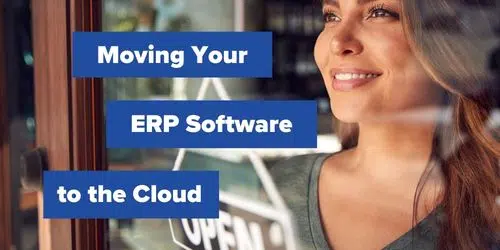Moving your ERP Software to the Cloud

Cloud ERP is fast becoming a popular choice for businesses of all sizes. According to the G2 Tech Marketplace, 63% of organizations choose cloud-based ERP systems over on-premise software. That’s because the Cloud offers many advantages over traditional on-premise ERP systems, including lower costs, increased flexibility and scalability, and easier access to data.
However, poor project and change management, implementation delays and cost overruns, software integration issues, and bad data quality are all too common outcomes. These problems typically come from unclear implementation goals, choosing the wrong vendor, or choosing the wrong fit for your company.
Don’t become another ERP failure statistic. If you’re thinking about moving your ERP system to the Cloud, there are a few things you need to consider first. In this blog post, we’ll review the important factors to keep in mind when considering, choosing, and implementing a new Cloud ERP solution:
- Benefits of modern Cloud-based ERP systems
- Choosing the right fit for your business
- Key factors for a successful Cloud ERP migration
Benefits of Modern, Cloud-based ERP systems
There are a number of benefits of migrating to a Cloud ERP system including:
-
Lower costs. Cloud ERP systems can often be more cost-effective than traditional on-premise ERP software because they typically require less hardware and maintenance. Plus there’s no need to hire extra IT staff to maintain the system, run reports, or upgrade the software.
-
Automatic upgrades. Cloud providers automatically manage system upgrades, so you’ll always have the latest version of the software.
-
Reliable security. Cloud ERP providers typically have robust security measures in place, including firewalls, data encryption, and user authentication. Businesses are able to take advantage of infrastructure they could never afford on their own.
-
Increased flexibility and scalability. Cloud ERP systems are highly flexible and scalable, making them ideal for businesses that are growing or have fluctuating needs.
-
Easier access to data. With Cloud ERP systems, users can access data from anywhere, at any time. This can be a major advantage for businesses with remote employees or multiple locations.
Choosing the right fit for your business
As we covered above, migrating to the Cloud offers a number of benefits, but only if it’s done correctly. Make sure you understand the many parts involved in migrating before making any decisions. Weigh the pros and cons carefully to determine if moving to the Cloud is the right choice for your company. A few factors to consider:
The type of business you have
- If you run a simple operation with limited products, services, and locations you might not need all the features a Cloud system offers. Conversely, if your business is complex with many moving parts, a Cloud solution will be better equipped to manage those needs than an on-premise system. The bottom line is that when it comes to Cloud ERP, there are a number of options available. Do your research and select a system that’s a good fit for your specific business needs. Keep in mind factors like cost, scalability, features, industry-specific functionality, and integrations when making your decision.
Budget
- One of the main benefits of Cloud ERP is its pay-as-you-go pricing model, which can help keep costs down. With an on-premise system, you have to pay for the software upfront, as well as any hardware and maintenance costs. By contrast, Cloud ERP providers typically charge a monthly or annual subscription fee, which can be more affordable for some businesses and offer a lower total cost of ownership.
IT infrastructure
- Cloud ERP systems are hosted off-site, so you don’t need to invest in on-premise infrastructure, such as servers and storage. This can save you a significant amount of money up front. Additionally, because Cloud ERP providers manage the system for you, there’s no need to hire extra IT staff to maintain it.
Level of comfort with change
- Migrating to a new system can be disruptive for any business. If you’re not comfortable with change, or your team is resistant to adopting new technology it can be a major obstacle to a successful implementation.
Business processes and industry-specific needs
- Cloud ERP systems are designed to be highly configurable, so they can be customized to fit your specific business processes. If you have unique industry-specific needs (like multiple entities or locations), look for a system that offers the flexibility to accommodate those requirements.
Not all providers are created equal
- When evaluating vendors, be sure to read reviews, compare pricing, and check customer satisfaction ratings. With a little research and by taking the time to do your homework up front, you can be sure you’re selecting the best Cloud ERP system for your business needs.
Choosing a trusted consultant
- By taking the time to find a partner you can trust you can be confident in the selection and implementation process. Your consultant should be able to understand how your processes work today and align them to your new system. Because there are a lot of moving parts in an ERP migration and technology is always evolving it’s important to find a company that has extensive experience, a proven process, and a track record of success.
Key Factors for a Successful Cloud ERP Migration
Once you’ve selected a Cloud ERP system, the next step is to begin planning your migration. While your ERP consultant should be able to guide you through every step of the process, it’s important to keep these factors in mind:
Assess your current IT infrastructure and resources
- In order to migrate your ERP system to the Cloud, you’ll need to assess your current IT infrastructure and identify any potential bottlenecks.
Map out your strategy
- Once you’ve assessed your current IT infrastructure, you can begin planning your Cloud ERP strategy. Determine which applications and data will be migrated to the Cloud, as well as how you’ll transition users and train staff on the new system. This should include an assessment of risks and dependencies.
Backup your data
- This may seem obvious but it’s one of the most important steps in any migration project. Be sure to backup all of your data before beginning the migration process.
Prepare for data conversion
- Cloud ERP systems typically use different database structures than on-premise systems. As such, you’ll need to convert your data to the new format. This can be a complex and time-consuming process, so be sure to plan accordingly.
Execute your migration plan
- You’ve mapped out your strategy and backed up your data; it’s time to execute the plan. This includes migrating applications and data to the Cloud, transitioning users, and training staff on the new system.
Test, test, and test again
- Once your data has been converted and migrated to the Cloud, thoroughly test the new system to ensure everything is working as expected. Be sure to test your applications and data in the Cloud before going live, and have a rollback plan in place in case of any issues.
Monitor and optimize your Cloud ERP system
- Once you’ve successfully migrated, it’s important to monitor your system closely and make sure it’s running optimally. This includes monitoring performance, security, and compliance. Your consultant is key here as well since part of their role should be to update you on the latest technology including after the implementation.
Conclusion
Modern Cloud ERP offers a number of advantages over traditional on-premise software, so moving to the cloud can be a great way to reduce cost and improve your business’s efficiency and competitiveness. While you don’t have to make migrating your on-premise ERP system to the cloud overly complicated or time-consuming, it’s important to carefully plan, research, and execute your migration in order to avoid costly mistakes and minimize disruption to your business.
With the help of a trusted consultant, you can migrate your ERP system to the Cloud with confidence.
“The busy work, the mundane tasks, the repetition are all gone. Also, the speed and efficiency gains allow me to spend more time on strategic projects. Thanks to the efficiencies we’ve gained with Sage Intacct Cloud ERP, we were able to downsize staff while raising productivity.” Renee Davis, B-29 Investments
Do you have questions about moving to the Cloud? We’ve done hundreds of successful implementations by following a “No Opportunity for Failure” approach with tested procedures and processes. Our team is happy to chat with you and answer any questions you may have about making the transition. Contact us or request a demo to get started.




